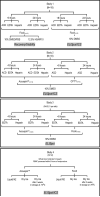Defining blood processing parameters for optimal detection of cryopreserved antigen-specific responses for HIV vaccine trials
- PMID: 17382342
- PMCID: PMC1904432
- DOI: 10.1016/j.jim.2007.02.003
Defining blood processing parameters for optimal detection of cryopreserved antigen-specific responses for HIV vaccine trials
Abstract
Interferon-gamma (IFN-gamma) ELISpot and intracellular cytokine staining (ICS) assays are routinely employed in clinical HIV vaccine trials to identify antigen-specific T cells in cryopreserved peripheral blood mononuclear cells (PBMC). Several parameters involved in blood collection, processing and shipping may influence immunological function of the resulting cells, including anticoagulant type, time from venipuncture to PBMC isolation/cryopreservation, method of PBMC isolation and procedure for sample shipping. We examined these parameters in single and multiple site studies, and found the length of time from venipuncture to cryopreservation is the most important parameter affecting performance of T cells in immunological assays. Comparing blood processed at 24 h after venipuncture with that processed within 8 h, we observed on average a modest reduction in PBMC viability ( approximately 8% decrease), a greater loss in cell recovery ( approximately 32%), and between 36-56% loss in IFN-gamma T cell frequencies by ELISpot assay. We also describe three cold shipping methods that maintain immunological function in appropriately cryopreserved PBMC. These data indicate that cryopreservation of PBMC should occur within 8 h of venipuncture for optimal performance. This narrow window for specimen processing has important implications in selecting and monitoring clinical sites with laboratory capacity to perform these procedures in future clinical trials.
Figures








References
-
- Bach MK, Brashler JR. Isolation of subpopulations of lymphocytic cells by the use of isotonically balanced solutions of Ficoll. I. Development of methods and demonstration of the existence of a large but finite number of subpopulations. Exp Cell Res. 1970;61:387–96. - PubMed
-
- Beattie T, Kaul R, Rostron T, Dong T, Easterbrook P, Jaoko W, Kimani J, Plummer F, McMichael A, Rowland-Jones S. Screening for HIV-specific T-cell responses using overlapping 15-mer peptide pools or optimized epitopes. Aids. 2004;18:1595–8. - PubMed
-
- Betts MR, Price DA, Brenchley JM, Lore K, Guenaga FJ, Smed-Sorensen A, Ambrozak DR, Migueles SA, Connors M, Roederer M, Douek DC, Koup RA. The functional profile of primary human antiviral CD8+ T cell effector activity is dictated by cognate peptide concentration. J Immunol. 2004;172:6407–17. - PubMed
-
- Boyum A. Isolation of lymphocytes, granulocytes and macrophages. Scand J Immunol. 1976;(Suppl 5):9–15. - PubMed
MeSH terms
Substances
Grants and funding
LinkOut - more resources
Full Text Sources
Other Literature Sources
Medical
Miscellaneous

